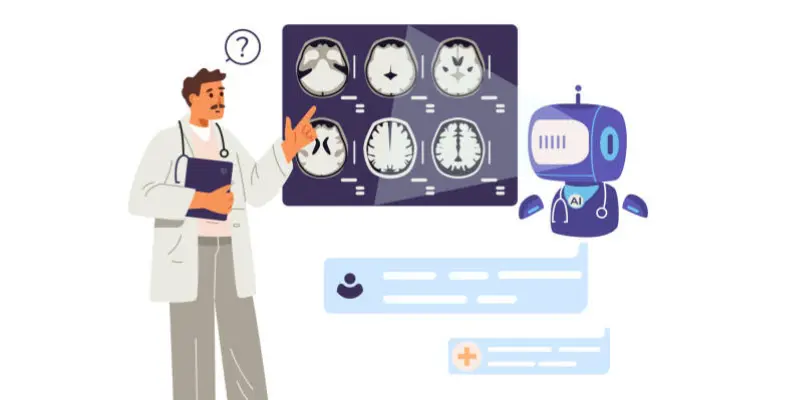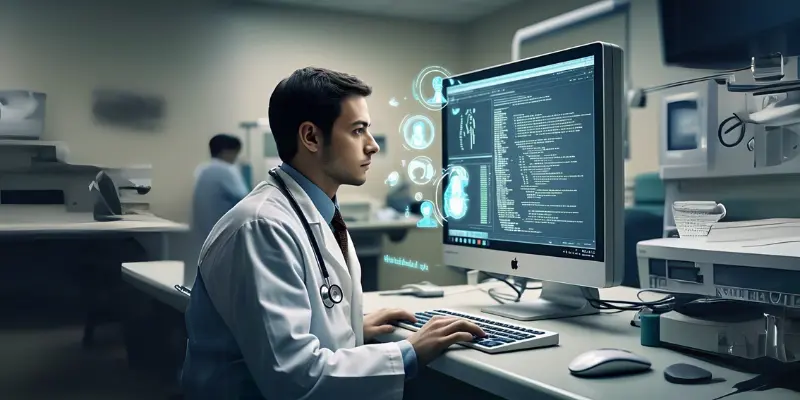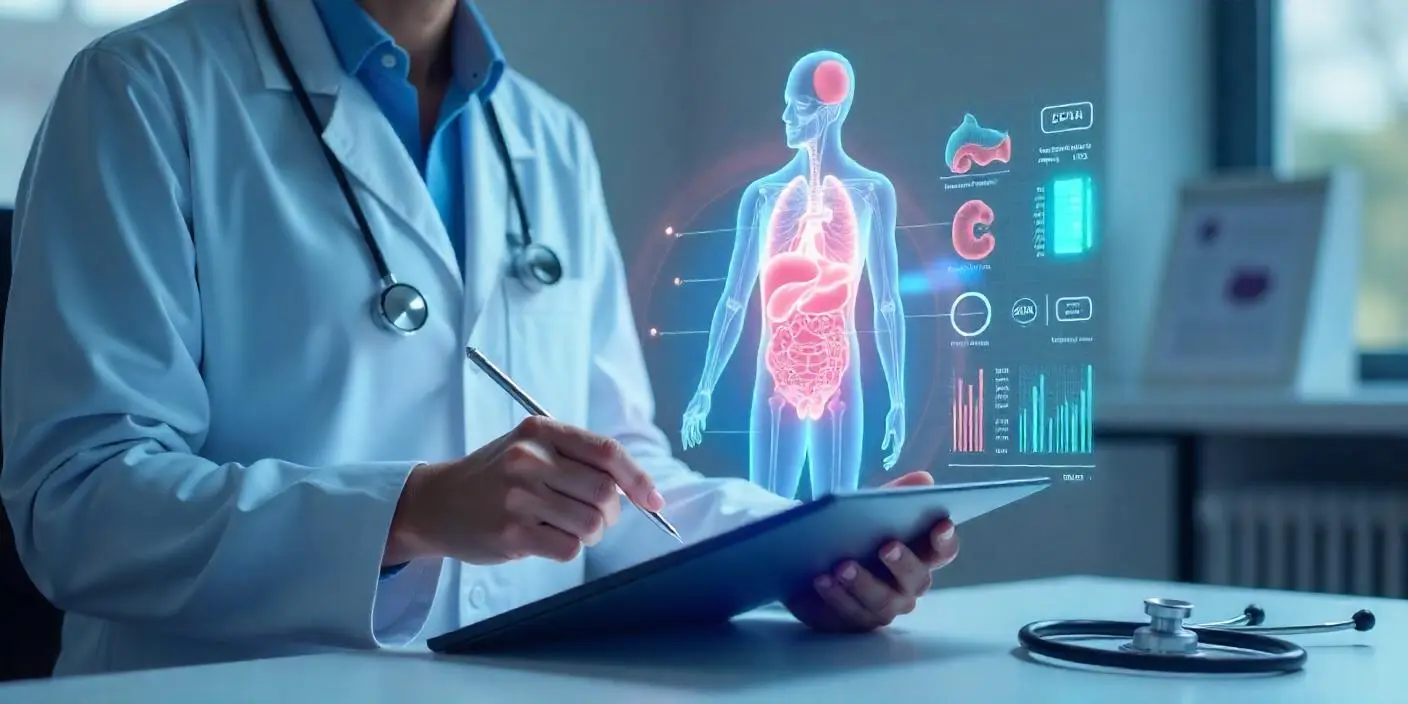What are the Different Types of AI in Healthcare
Published: 7 Mar 2025
Hi Guy’s! My last lecture in Healthcare AI was about applications of AI in healthcare in which I do my best to explain the applications in a way you easily understand by giving relevant examples. Today we talk about Types of AI in Healthcare.
Artificial Intelligence is revolutionizing healthcare by making medical processes smarter and faster. There are different types of AI used in healthcare, each playing a unique role in improving patient care, diagnosing diseases and even predicting health trends. Understanding these types of AI is important because it helps us see how technology can make healthcare more efficient and accessible. Whether it’s using AI for diagnosing diseases, personalizing treatments or managing hospital systems, knowing these types will give us a clearer picture of how AI is shaping the future of medicine. Let’s explore the different types of AI and how they are transforming healthcare for the better.

Types of AI in Healthcare
AI is making a big impact in healthcare by helping doctors and hospitals to provide better care and streamline their processes. From diagnosing diseases to predicting outcomes, AI is revolutionizing the way we approach medical treatments. Understanding the different types of AI used in healthcare can help us appreciate how it’s improving lives all around the world. We are going to explore the following types of AI in Healthcare:
- Machine Learning (ML)
- Natural Language Processing (NLP)
- Computer Vision
- Expert Systems
- Robotics
- Deep Learning
- Predictive Analytics
- Cognitive Computing
- Chatbots and Virtual Assistants
- Automated Diagnostics
1. Machine Learning (ML)
Machine Learning (ML) is a type of artificial intelligence that allows computers to learn from data and make predictions or decisions without being explicitly programmed. In healthcare, ML uses algorithms to analyze medical data, identify patterns and improve decision-making processes. It essentially enables machines to “learn” from experience, much like a human would.
How is ML Used in Healthcare?
Machine Learning is used in various healthcare areas:
- Predicting Diseases: ML models can analyze patient data to predict the likelihood of developing certain conditions like diabetes or heart disease.
- Diagnostic Assistance: ML helps in diagnosing diseases by analyzing medical images such as X-rays or MRIs, and suggesting potential conditions.
- Personalized Treatment: ML can recommend treatment plans tailored to individual patients based on their medical history and genetic information.
- Drug Discovery: ML algorithms analyze chemical compounds and help scientists discover new drugs faster by predicting their effectiveness.
What Advantages Does ML Bring to Healthcare?
- Improved Accuracy: ML can process large amounts of data and provide more accurate diagnoses than traditional methods.
- Faster Decision Making: By automating analysis, ML helps doctors to make quicker decisions, and improve patient care.
- Predictive Power: ML can predict health outcomes, enabling early interventions and preventing diseases before they progress.
- Cost-Effective: ML can reduce healthcare costs by streamlining processes and improving the efficiency of treatments and diagnoses.
What Are the Obstacles in Using ML?
- Data Privacy: Since ML relies on large datasets, ensuring the privacy and security of patient information is a major concern.
- Quality of Data: ML models are only as good as the data they are trained on. Incomplete or inaccurate data can lead to incorrect predictions.
- Complexity: Developing and training ML models can be complex, requiring skilled professionals and significant resources.
- Regulatory Hurdles: Healthcare is a highly regulated field, and implementing ML-based systems can be slow due to the need for approval from regulatory bodies.
Machine Learning is transforming healthcare by improving diagnostics, personalizing treatments and predicting health outcomes but it also faces challenges like data security and model accuracy. Understanding its applications, benefits and challenges helps healthcare providers make informed decisions about integrating ML into their practices.
2. Natural Language Processing (NLP)
Natural Language Processing (NLP) is a branch of artificial intelligence that helps computers understand, interpret and respond to human language in a way that is both meaningful and useful. In healthcare, NLP is used to process and analyze large volumes of text data such as patient records, clinical notes and research papers. It allows machines to read and understand the language used by doctors and patients, making it easier to extract valuable insights from written information.

How is NLP Applied in Medical Fields?
NLP has several important applications in healthcare:
- Clinical Documentation: NLP can automatically extract key information from patient records such as symptoms, diagnosis and treatments, making it easier for healthcare providers to track patient health over time.
- Voice Recognition: Healthcare professionals can use voice-to-text systems powered by NLP to dictate notes during patient visits. This reduces paperwork and allows for quicker documentation.
- Sentiment Analysis: NLP can analyze patient feedback, social media posts or reviews to gauge public sentiment about a hospital, treatment or healthcare product.
- Information Retrieval: NLP helps researchers and doctors find relevant studies, medical guidelines and treatment options by processing and understanding vast amounts of medical literature.
What Are the Benefits of Using NLP?
- Time-Saving: NLP automates the process of reading and interpreting medical text, saving healthcare workers hours of manual data entry and review.
- Improved Accuracy: By extracting relevant information from clinical texts, NLP reduces human error in documentation and analysis.
- Better Decision Making: NLP enables healthcare professionals to access and analyze patient histories and medical literature quickly which aids in making more informed decisions.
- Enhances Patient Care: With faster and more accurate access to patient data, doctors can focus more on treatment and less on administrative tasks, leading to better patient care.
What Challenges Do NLP Systems Face?
- Complexity of Medical Terminology: Healthcare language is full of technical terms, abbreviations and jargon that can be difficult for NLP systems to interpret correctly, leading to potential errors in understanding.
- Data Privacy and Security: Handling sensitive medical data requires strong security measures to ensure that patient privacy is maintained while using NLP systems.
- Ambiguity in Language: Human language is often ambiguous with words that can have different meanings based on context. NLP models can sometimes struggle with these subtleties, leading to inaccurate conclusions.
- Integration with Existing Systems: Healthcare systems are often complex and integrating NLP technologies with existing patient records or hospital management software can be time-consuming and costly.
Natural Language Processing in healthcare helps streamline data analysis and improves overall efficiency by converting unstructured text into actionable insights. However, it faces challenges such as dealing with complex medical language and ensuring privacy and security. Despite these obstacles, NLP is proving to be a valuable tool for improving patient care and operational efficiency in healthcare settings.
3. Computer Vision
Computer Vision is a field of artificial intelligence that enables computers to interpret and understand visual information from the world, such as images and videos. In healthcare, computer vision is used to analyze medical images like X-rays, MRIs, CT scans and even photos of wounds or skin conditions. The goal is for computers to “see” and interpret visual data just like humans do but often with greater speed and precision.

How is Computer Vision Used in Medical Imaging?
Computer vision has several important applications in healthcare:
- Medical Image Analysis: It helps doctors analyze X-rays, MRIs and CT scans to detect diseases like cancer, pneumonia or fractures. Computer vision can highlight suspicious areas in images for further investigation.
- Automated Diagnosis: In some cases, computer vision can automatically diagnose conditions from medical images. For example, it can detect early signs of diabetic retinopathy (eye damage caused by diabetes) from eye scans.
- Surgical Assistance: Computer vision can assist surgeons during operations by providing real-time analysis of the surgical area, helping them make precise decisions.
- Telemedicine: Computer vision is used in telehealth applications to evaluate patients remotely such as analyzing skin conditions or injuries through images sent by patients.
How Does Computer Vision Improve Diagnostics?
- Accuracy: Computer vision can often detect conditions that might be missed by the human eye, improving diagnostic accuracy.
- Speed: It processes medical images faster than human doctors, allowing for quicker diagnoses and treatment.
- Consistency: Unlike humans, who may be affected by fatigue or distractions, computer vision systems are consistent, providing the same level of performance at all times.
- Cost-Effective: By automating tasks like image analysis, healthcare systems can reduce the workload on medical professionals and cut down on costs.
What Are the Challenges of Using Computer Vision?
- Data Quality: Computer vision systems rely heavily on high-quality medical images. Poor-quality images or variations in imaging equipment can lead to incorrect analysis.
- Training Data: To work accurately, computer vision models need to be trained on large datasets of medical images. Gathering enough labeled data can be time-consuming and expensive.
- Interpretation Limitations: While computer vision can help detect certain conditions, it is not foolproof. Some complex or subtle medical issues might still require a human expert to interpret.
- Integration: Integrating computer vision systems into existing healthcare infrastructures like hospitals or clinics can be a complex process and requires significant investment.
Computer Vision is transforming the way healthcare professionals analyze medical images by offering faster, more accurate and more consistent results. However, challenges like data quality, training and system integration need to be addressed to fully harness its potential in medical diagnostics.
4. Expert Systems
Expert Systems are a type of artificial intelligence designed to mimic the decision-making ability of a human expert in specific fields. In healthcare, these systems are used to assist doctors by providing knowledge-based recommendations or solutions based on a set of rules and input data. Essentially, expert systems are like having a knowledgeable advisor who helps doctors make decisions by analyzing patient data, symptoms and medical history.
How Are Expert Systems Used in Clinical Decision-Making?
Expert systems have many applications in healthcare:
- Diagnosis Assistance: Expert systems can help diagnose diseases by analyzing symptoms, lab results and medical history. For example, if a doctor inputs a patient’s symptoms, the system might suggest possible conditions.
- Treatment Recommendations: These systems can suggest treatment plans based on patient data and the latest medical guidelines, ensuring that healthcare providers follow best practices.
- Clinical Guidelines: Expert systems can help doctors stay up-to-date with clinical guidelines by offering advice that follows the latest medical research and protocols.
- Drug Interaction Alerts: Expert systems can warn healthcare providers about potential harmful drug interactions, ensuring patient safety.
How Do Expert Systems Help Medical Professionals?
- Increased Accuracy: Expert systems reduce human error by providing evidence-based recommendations and identifying conditions that might be missed by doctors.
- Faster Decision Making: With quick access to diagnostic tools and treatment options, expert systems allow doctors to make faster decisions and improve patient care.
- Support for Complex Cases: In challenging or unfamiliar cases, expert systems provide a second opinion, helping doctors make informed decisions.
- Cost-Effective: By assisting healthcare providers in making accurate diagnoses and treatment plans, expert systems can reduce unnecessary tests and procedures, saving time and money.
What Limitations Do Expert Systems Have?
- Data Dependency: Expert systems rely on large amounts of accurate and up-to-date data. If the data input is incorrect or incomplete, the system’s recommendations may not be reliable.
- Lack of Human Intuition: While expert systems are great at following rules, they lack the human intuition and experience that doctors bring to their practice. They may miss complex, nuanced patient factors.
- Expensive Setup: Developing and maintaining expert systems requires a significant investment in technology, data management and training.
- Resistance to Adoption: Some healthcare providers may be hesitant to trust expert systems or rely on them, especially if they feel the system could interfere with their clinical judgment.
Expert Systems are an important tool in healthcare, offering valuable support in diagnosis, treatment planning and ensuring that best practices are followed. However, challenges like data dependency and the need for human expertise still remain as important factors in their effectiveness.
5. Robotics
Robotics in healthcare refers to the use of robots to perform various tasks that were traditionally carried out by humans. These robots can assist in surgeries, help with patient care and even automate administrative tasks. In healthcare, robots are designed to work alongside medical professionals, improving the quality and efficiency of care and sometimes performing tasks more accurately than humans.

How is Robotics Used in Surgery and Patient Care?
Robotics has a wide range of applications in healthcare:
- Surgical Assistance: Robotic systems like the da Vinci Surgical System assist surgeons by providing enhanced precision during surgery. Robots can make smaller and more accurate incisions, leading to faster recovery times and less pain for patients.
- Robotic Prosthetics: Robots are used to create prosthetics (artificial limbs) that help patients regain mobility. These prosthetics are often designed with advanced robotics to provide more natural movement.
- Patient Care Robots: In hospitals and nursing homes, robots can assist with tasks like delivering medication, moving patients or even providing companionship to elderly patients.
- Rehabilitation Robots: Robotics is used in physical therapy and rehabilitation, where robots assist patients in performing exercises to regain strength and movement after an injury or surgery.
What Advantages Do Robotic Systems Offer?
- Precision: Robotic systems provide highly accurate movements which are particularly useful in surgeries that require minimal incision or delicate handling.
- Reduced Risk of Human Error: Robots can perform repetitive tasks with high consistency and accuracy, reducing the likelihood of errors during procedures.
- Faster Recovery: With less invasive procedures, patients can recover more quickly and experience less pain post-surgery.
- Increased Efficiency: Robots can handle routine tasks like delivering supplies or administering medications, freeing up healthcare staff to focus on more critical care.
What Are the Barriers to Adopting Robotics in Healthcare?
- High Costs: Robotic systems are expensive to develop, purchase and maintain which can be a barrier for many healthcare facilities.
- Training and Integration: Healthcare professionals must be trained to use robotics effectively and integrating these systems into existing healthcare settings can be complex.
- Limited Availability: Not all hospitals have access to the latest robotic technology due to its cost, meaning that patients may not benefit from these advancements unless they are in well-funded institutions.
- Technical Issues: Like any technology, robots can face technical issues, such as system malfunctions or software errors, which could disrupt medical procedures or patient care.
Robotics is revolutionizing healthcare by providing more precise surgeries, assisting in rehabilitation, and helping with patient care. While the technology brings many benefits, challenges like cost, training, and technical issues need to be addressed for wider adoption in healthcare systems.
6. Deep Learning
Deep Learning is a subset of Machine Learning that uses artificial neural networks to process data in layers, similar to how the human brain works. In healthcare, deep learning is used to analyze large amounts of data, such as medical images, patient records, and genetic information. It helps systems “learn” from the data, improving their ability to make predictions and decisions without human intervention.

How is Deep Learning Used for Diagnosis and Treatment?
Deep learning has several key applications in healthcare:
- Medical Imaging: Deep learning algorithms can analyze medical images like X-rays, MRIs and CT scans to detect diseases such as cancer, heart conditions and neurological disorders. It can identify patterns in the images that might not be visible to the human eye.
- Predicting Disease: Deep learning models can analyze patient data including medical history and lifestyle information to predict the likelihood of developing certain conditions, such as diabetes, heart disease or cancer.
- Personalized Treatment: By analyzing genetic data, deep learning can help doctors recommend personalized treatment plans for patients based on their unique genetic makeup and medical history.
- Drug Development: Deep learning is also used to identify potential drug candidates by analyzing large datasets of chemical compounds and predicting their effectiveness in treating diseases.
Benefits: How Does Deep Learning Improve Patient Outcomes?
- Increased Accuracy: Deep learning algorithms can process large amounts of data and identify patterns that may not be apparent to human doctors, leading to more accurate diagnoses.
- Early Detection: Deep learning systems can detect diseases at an early stage, improving the chances of successful treatment and recovery.
- Efficiency: With deep learning, healthcare professionals can get faster results from diagnostic tests, allowing them to make decisions quickly and start treatment earlier.
- Personalized Care: By analyzing a patient’s genetic data, deep learning helps to create more personalized treatment plans that are tailored to the individual needs.
What Challenges Come with Deep Learning?
- Data Requirements: Deep learning models require large amounts of data to train effectively. Gathering this data can be time-consuming and costly, and it must be accurate and representative of diverse patient populations.
- Interpretability: One challenge with deep learning is that it can be difficult to understand how the system makes its decisions. This “black box” issue means that doctors may not always know why the system made a certain recommendation.
- Data Privacy: Handling sensitive medical data requires strict privacy measures and deep learning systems must be carefully managed to ensure patient confidentiality is maintained.
- Cost: Developing, training and implementing deep learning systems can be expensive and smaller healthcare institutions may struggle to afford the technology.
Deep Learning is a powerful tool in healthcare that improves diagnostics, enables early detection and personalizes treatment. While it offers many benefits, challenges like data requirements, interpretability and cost need to be addressed to ensure its widespread adoption and effectiveness in healthcare.
7. Predictive Analytics
Predictive Analytics uses data, statistical algorithms and machine learning techniques to identify the likelihood of future outcomes based on historical data. In healthcare, it predicts disease outbreaks, patient outcomes and even the effectiveness of treatments. By analyzing patterns in data, predictive analytics allows healthcare providers to make better-informed decisions about patient care and resource management.
How is Predictive Analytics Used in Forecasting Health Trends?
Predictive analytics is applied in various healthcare areas:
- Disease Prediction: Predictive models can analyze patient data such as medical history and lifestyle factors, to predict the risk of developing chronic conditions like diabetes, heart disease or cancer.
- Patient Outcome Prediction: It can forecast a patient’s recovery trajectory, helping doctors adjust treatment plans based on predicted outcomes.
- Hospital Readmission Risk: Predictive analytics can identify patients who are at high risk of being readmitted to the hospital, allowing healthcare providers to implement preventive measures.
- Pandemic Tracking: During outbreaks like the COVID-19 pandemic, predictive analytics is used to track the spread of the virus and predict future cases, helping governments and healthcare providers prepare and respond effectively.
How Does Predictive Analytics Help in Early Detection of Diseases?
- Early Intervention: By predicting the risk of diseases, healthcare providers can take action early, potentially preventing the development of serious conditions.
- Better Resource Management: Predictive analytics helps healthcare facilities to manage resources like staff and equipment more effectively by forecasting patient needs and trends.
- Improved Patient Care: Healthcare professionals can offer personalized care based on the predictions, optimizing treatment plans for individual patients.
- Cost Savings: Predictive models reduce unnecessary procedures and hospital readmissions, lowering healthcare costs for both patients and healthcare systems.
What Challenges Exist in Predictive Healthcare Analytics?
- Data Quality: Predictive analytics relies on high-quality data. Inaccurate or incomplete data can lead to incorrect predictions and decisions.
- Data Privacy: Since predictive analytics requires sensitive patient data, ensuring the privacy and security of this information is a major concern.
- Complexity: Building and maintaining predictive models can be complex, requiring specialized knowledge and significant resources to manage large datasets.
- Adoption Resistance: Some healthcare providers may be hesitant to trust predictive models over clinical judgment, leading to slower adoption of this technology in some settings.
Predictive Analytics is an exciting tool that helps healthcare professionals anticipate and prevent future health issues. It improves early detection, enhances patient care and helps in managing resources efficiently. However, challenges like data quality, privacy and adoption hurdles need to be addressed to fully realize its potential in healthcare.
8. Cognitive Computing
Cognitive Computing refers to systems that simulate human thought processes in analyzing complex data. These systems use artificial intelligence to mimic human-like understanding, learning and reasoning to solve problems. In healthcare, cognitive computing helps machines understand context, interpret unstructured data like medical records and offer insights that support clinical decision-making, much like how a human expert would.

How is Cognitive Computing Applied to Clinical Decision-Making?
Cognitive computing has many applications in healthcare:
- Clinical Decision Support: Cognitive systems assist doctors in making better decisions by analyzing patient data, medical literature and clinical guidelines. This helps doctors choose the most appropriate treatment based on up-to-date information.
- Personalized Medicine: By considering the individual characteristics of a patient such as genetic information, cognitive computing can recommend personalized treatment plans that are tailored specifically to the patient’s needs.
- Medical Research: Cognitive computing helps researchers analyze vast amounts of medical literature and patient data to identify trends, new treatments and potential breakthroughs in healthcare.
- Natural Language Processing (NLP): Cognitive systems use NLP to process and understand unstructured data such as patient notes, emails or medical records, making it easier for healthcare providers to extract meaningful insights.
What Are the Benefits of Cognitive Computing in Healthcare?
- Improved Decision-Making: Cognitive systems provide doctors with more information and better insights, helping them make more informed decisions that lead to better patient outcomes.
- Efficiency: By automating data analysis and processing, cognitive computing reduces the time doctors spend on administrative tasks, allowing them to focus more on patient care.
- Personalized Treatment: These systems can help in creating personalized treatment plans by considering a patient’s unique medical history, genetics and lifestyle, leading to more effective treatments.
- Better Patient Engagement: Cognitive computing can help patients understand their conditions and treatment options better, allowing for more active participation in their healthcare journey.
What Challenges Face Cognitive Computing in Healthcare?
- Data Complexity: Healthcare data is often unstructured (e.g., handwritten notes, medical images), making it difficult for cognitive systems to interpret and process efficiently.
- Integration with Existing Systems: Integrating cognitive computing solutions into existing healthcare infrastructures can be difficult and costly, especially when systems are outdated or incompatible.
- Data Privacy: Since cognitive computing systems require access to sensitive patient data, ensuring that patient privacy is protected is a major concern.
- Reliability: While cognitive systems can assist doctors, they are not infallible. There’s still a need for human judgment in clinical decision-making and relying solely on these systems could result in errors.
Cognitive Computing is helping healthcare providers enhance decision-making, improve patient care and streamline operations by mimicking human-like understanding and reasoning. Despite the challenges of data complexity and privacy concerns, cognitive computing continues to show promise in transforming how healthcare is delivered.
9. Chatbots and Virtual Assistants
Chatbots and virtual assistants are AI-powered systems that interact with users through text or voice. They can understand and respond to patient inquiries, schedule appointments, provide health advice and assist in administrative tasks. In healthcare, these tools help to improve patient engagement, reduce the workload on healthcare professionals and provide faster responses to common healthcare-related questions.
How Are Chatbots and Virtual Assistants Used for Patient Interaction and Administrative Tasks?
Chatbots and virtual assistants have a variety of uses in healthcare:
- Patient Support: Virtual assistants can provide patients with immediate answers to their medical questions, whether it’s about symptoms, medications or general health advice. This can be done through text or voice.
- Appointment Scheduling: Chatbots can handle appointment bookings, reminders and cancellations, making it easier for patients to manage their visits without contacting the clinic directly.
- Pre-screening for Symptoms: Before seeing a doctor, patients can interact with chatbots to describe their symptoms. Based on their input, the chatbot may provide initial advice or direct them to the appropriate care.
- Medication Reminders: Virtual assistants can remind patients to take their medications on time, improving adherence to treatment plans and helping prevent medication errors.
- Mental Health Support: Some chatbots are designed to provide mental health support by offering coping strategies, relaxation exercises or simply acting as someone for patients to talk to.
How Do Chatbots Improve Healthcare Efficiency?
- 24/7 Availability: Chatbots and virtual assistants are available at all times, offering immediate responses to patient questions or requests, regardless of the time of day.
- Reduced Workload: By handling routine tasks such as appointment scheduling, answering FAQs and providing general health information, chatbots free up time for healthcare providers to focus on more critical tasks.
- Cost-Effective: Automating tasks with chatbots reduces the need for additional staff, saving healthcare facilities money on administrative work.
- Enhanced Patient Experience: Patients can receive quick and personalized assistance, leading to a more positive experience with the healthcare system.
- Improved Communication: Virtual assistants ensure that patients receive consistent and accurate information, improving overall communication between patients and healthcare providers.
What Issues Arise with Chatbots in Healthcare?
- Limited Understanding: Although AI is improving, chatbots may still struggle to understand complex medical queries or provide nuanced responses which can lead to frustration for patients.
- Privacy and Security: Handling sensitive patient information through chatbots raises concerns about data security and privacy. Ensuring that these systems comply with healthcare regulations, such as HIPAA in the U.S., is crucial.
- Reliability: Chatbots can’t replace human doctors and may sometimes provide incorrect or incomplete information, which can lead to poor health outcomes if relied on too heavily.
- Integration Challenges: Integrating chatbots with existing healthcare systems, such as patient management software or electronic health records, can be complex and time-consuming.
Chatbots and virtual assistants are improving healthcare by providing round-the-clock support, reducing administrative workloads and enhancing patient experiences. However, challenges related to understanding complex medical queries, privacy and system integration need to be addressed to maximize their effectiveness.
10. Automated Diagnostics
Automated Diagnostics refers to the use of AI systems to automatically analyze medical data and provide diagnostic results without human intervention. These systems are designed to assist healthcare professionals by identifying diseases, conditions or abnormalities in a patient’s health data. Automated diagnostic tools can analyze things like medical images, lab results or patient records and make accurate predictions about the patient’s health status.

How is Automated Diagnostics Used in Disease Detection?
Automated diagnostics is used in a variety of healthcare applications:
- Medical Imaging: AI tools can analyze medical images like X-rays, CT scans,and MRIs to detect conditions such as cancer, fractures or abnormalities in organs. For example, an AI system can automatically spot tumors in mammograms or identify signs of pneumonia in chest X-rays.
- Blood Test Analysis: Automated systems can process and interpret results from blood tests, helping to quickly diagnose conditions like infections, anemia or kidney disease.
- Genetic Testing: AI-powered diagnostic tools analyze genetic data to predict the risk of genetic disorders and identify potential health issues that could be passed on to future generations.
- Monitoring Chronic Conditions: AI can continuously monitor patients with chronic conditions like diabetes or heart disease by analyzing data from wearable devices. This helps in tracking health trends and adjusting treatment plans accordingly.
How Does Automated Diagnostics Speed Up Healthcare Processes?
- Increased Speed: Automated diagnostic systems can analyze large volumes of data much faster than humans, allowing healthcare providers to diagnose conditions quickly and accurately.
- Enhanced Accuracy: By using algorithms trained on large datasets, AI can identify patterns and anomalies that may be missed by human clinicians, improving the overall accuracy of diagnoses.
- Consistency: Unlike human doctors who may experience fatigue or distraction, automated systems provide consistent results every time, ensuring reliable diagnostic decisions.
- Cost-Effective: Automation reduces the need for manual analysis, saving both time and money. This allows healthcare facilities to reduce costs while maintaining high-quality care.
- Improved Patient Outcomes: Faster and more accurate diagnoses enable quicker treatments, which can lead to better patient outcomes, especially in critical conditions.
What Challenges Do Automated Diagnostics Face?
- Data Quality: The effectiveness of automated diagnostics depends on the quality of the data. Poor-quality images, incomplete patient records or incorrect lab results can lead to inaccurate diagnoses.
- Data Privacy: Since automated diagnostic systems handle sensitive patient data, ensuring the privacy and security of this information is a major concern. Strict adherence to privacy laws and regulations is essential.
- Integration with Healthcare Systems: Integrating automated diagnostic tools into existing healthcare infrastructure can be complex and expensive, requiring seamless coordination with electronic health records (EHR) and other hospital systems.
- Limited Ability for Complex Cases: While automated systems can be highly accurate for common conditions, they may struggle with more complex or rare diseases that require human expertise and intuition for diagnosis.
- Regulatory Challenges: Automated diagnostic systems must meet strict regulatory standards before they can be used in clinical settings. The approval process can be time-consuming and costly.
Automated Diagnostics is transforming healthcare by providing faster, more accurate and cost-effective diagnostic tools. However, challenges such as data quality, integration issues and regulatory hurdles need to be addressed to ensure the widespread use and reliability of these systems.
Which Type is Best
Although the selection of best depends on specific needs, Machine Learning (ML) truly stands out as one of the most transformative AI technologies in healthcare. Its ability to learn from vast amounts of data and continuously improve its predictions makes it an invaluable tool for diagnosing diseases, personalizing treatments and even predicting future health outcomes. What makes ML especially remarkable is how it empowers healthcare professionals to make faster, more accurate decisions—saving time and potentially lives.
If you’re exploring the potential of AI in healthcare, I highly recommend diving into ML. Its real-world applications are not only groundbreaking but also have a lasting impact on improving patient care and outcomes. With its growing capabilities, Machine Learning is, without a doubt, a game-changer in the field.
Conclusion
AI in healthcare is changing the way we diagnose, treat and manage diseases. Each type of AI has its own strengths, from helping doctors make better decisions to improving patient experiences with virtual assistants. As healthcare continues to evolve, understanding these AI types can help you stay ahead. Whether you’re a healthcare professional looking to streamline workflows or a patient curious about AI-driven care, there’s an AI solution for you. Explore these types, see how they fit your needs and embrace the future of healthcare with confidence!
FAQs on Types of AI in Healthcare
Here are some frequently asked questions about Types of AI in Healthcare;
Machine Learning is a subset of Artificial Intelligence (AI) that focuses on algorithms that can learn and make predictions based on data. AI, on the other hand, is a broader field that includes any machine that simulates human intelligence. ML is just one way AI can be used in healthcare.
Machine Learning analyzes large amounts of medical data such as images or patient records to identify patterns and make predictions. This helps doctors detect diseases more accurately and early which can lead to better treatment outcomes. It can even suggest diagnoses that might not be immediately obvious to a human doctor.
Machine Learning is widely used for conditions that involve large amounts of data like cancer detection, heart disease and diabetes. However, its effectiveness depends on the quality of data and the complexity of the disease. It may not be as effective for rare or very complex diseases with little data available.
Machine Learning can assist doctors by providing more accurate data analysis and predictions but it is not meant to replace them. The human touch, expertise and judgment are essential in healthcare. ML is a tool to enhance decision-making, not replace healthcare professionals.
Machine Learning analyzes a patient’s medical history, genetics and lifestyle data to recommend personalized treatment plans. By considering all these factors, ML can suggest the most effective treatments for an individual, making healthcare more tailored and efficient. This leads to better outcomes for patients.
The time it takes for an ML model to become effective varies depending on the complexity of the data and the model. It often requires several months or even years to train using vast datasets. However, once trained, the model can provide valuable insights quickly and accurately.
Machine Learning needs large datasets, such as medical images, patient records, genetic data, and test results, to learn and make predictions. The more high-quality data the model is trained on, the better its accuracy and reliability. It’s important that the data is both accurate and comprehensive.
Yes, Machine Learning can analyze data related to mental health, such as speech patterns, behavior, and questionnaires, to help diagnose conditions like depression or anxiety. It can also assist in tracking patient progress over time. However, mental health diagnoses still rely heavily on human expertise.
Machine Learning systems in healthcare must comply with strict privacy regulations like HIPAA in the U.S. to ensure patient data is secure. However, it’s important to continuously monitor and enforce data privacy policies. Patients’ sensitive data must be encrypted and handled with care to protect their privacy.
Even small healthcare practices can use Machine Learning to automate routine tasks like patient scheduling, symptom checking, or predicting patient needs. With the help of affordable ML tools, smaller practices can improve efficiency and offer more accurate diagnoses without needing extensive resources. This can lead to better patient care and streamlined operations.





